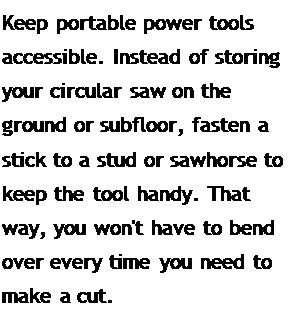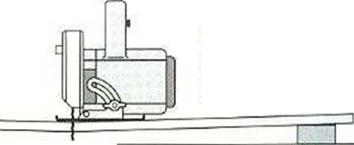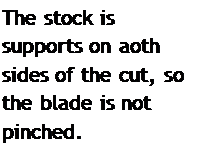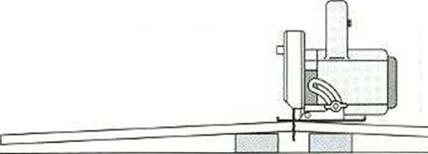Safety on the Job WORKING SAFELY ON A CONSTRUCTION SITE
WORKING ON A CONSTRUCTION SITE is not a * Don’t drink (or do drugs) while doing construe-
sunny stroll in lhe park. There are all kinds of tion work.





unusual, uncomfortable, and potentially hazardous conditions you may encounter—uneven ground, troublesome weather, boards with protruding nails, and sloped roof surfaces that challenge your balance. Learning how to work safely and effectively in a construction environment is just one more skill that you need to acquire, such as hammering a nail or sawing a board. Here are some basic suggestions to keep you safe and productive:
a Wear good shoes, clothes that fit well, long – sleeved shirts, long pants, a hat with a brim, and sunscreen. Protective clothing is also available for those who are particularly sensitive to the sun (see Resources on p. 278). Leave jewelry at home, and bunch up long hair, so it doesn’t get caught in a power tool.
^ Protect your eyes with safety glasses or goggles when sawing or nailing.
Protect your ears. Hearing damage is cumulative and permanent; once you’ve damaged your ears, you can’t undo it. I keep a few sponge earplugs in a 35mm film canister stored in my tool bucket. Place a set of good earplugs or earmuffs by the chopsaw and table saw if you have those tools on the job site.
a Protect your lungs with a dust mask, which will keep large particles from entering your lungs.
^ To prevent back injuries, remember to lift with your legs, not your back. If you’ll be working on your knees for a long period, wear kneepads.
* To reduce the risk of tripping or stepping on a nail, keep your work area clean.
a If you see any nails sticking out of boards, either bend the nails or remove them.
ж Never throw anything off a roof without looking to see whether anyone is below.
a Work with a clear head and pay attention to what you and others around you are doing. Be especially careful toward the end of the day, when you are physically tired.
a Pay attention to your inner voice. If you feel that something might be dangerous, ask for help or figure out a better way to do it.
^ Take care of your body. Don’t forget to rest and drink plenty of water. Your body can become dehydrated rapidly on a hot, dry day. If you aren’t visiting the Porta Potti® regularly, you aren’t drinking enough water.
a Keep your tools sharp and clean, take care of them, and Heal Lliem well.
* Take a course in basic first aid.



Although power tools can’t replace hand tools, they sure do make construction work easier. Power tools make work move along more efficiently. 1 wouldn’t want to be with- out them.
T he circular saw has been around since the 1920s, but it didn’t really catch on until the housing boom began after World War II. These davs, manv homeowners have one in the garage. For a builder, this portable power tool is indispensable. The most popular circular saws are designed to hold 7l4-in.-dia.
blades. In the eastern part of the U. S., most carpenters prefer direct-drive saws, often referred to as sidewinders (see the bottom left photo on the facing page). In the West, carpenters mainly use the heavier worm-drive models (see the bottom right photo on the lacing page). Check out both to see which one you prefer. Above all, buy quality. Light, low – priced homeowner models aren’t in the same league with professional models.
Tips for using your saw safely and accurately are listed on p. 34. Some of them apply to other power tools as well. As wit i any power tool, be sure to study and follow the instructions in the manual.
Safety on the Job AVOIDING KICKBACK





WHEN THE BLADE OF A CIRCULAR SAW gets pinched by the wood, the power of the motor can force the saw backward—a safety hazard called kickback. In extreme cases, the saw can jump away from the material with the blade still spinning, harming anything in its path. To prevent kickback when using a circular saw, follow these guidelines:
a Use a sharp, carbide-tipped blade. a Cut in a straight line.
^ Let the saw do the cutting—don’t force it. Forcing the cut can cause the blade to bind and kick back.
a Always provide proper support for the stock.
Avoid setups that allow the material being cut to pinch the blade (see the illustration at right).
* If a kickback does occur, release the saw trigger immediately and let the blade stop. As long as the blade guard is working properly, there is little danger of injury. Don’t resume cutting until the cause of the kickback is determined and corrected.
SUPPORTING STOCK PROPERLY WHEN CUTTING
WITH A CIRCULAR SAW
Not enough support
|
|
|
Not enough support |
|
The stock sags at bon ends, pinching the blade. |
Proper support
When you are cutting wood, support it properly. Unsupported wood can pinch the blade and cause the saw to kick back.







Leave a reply